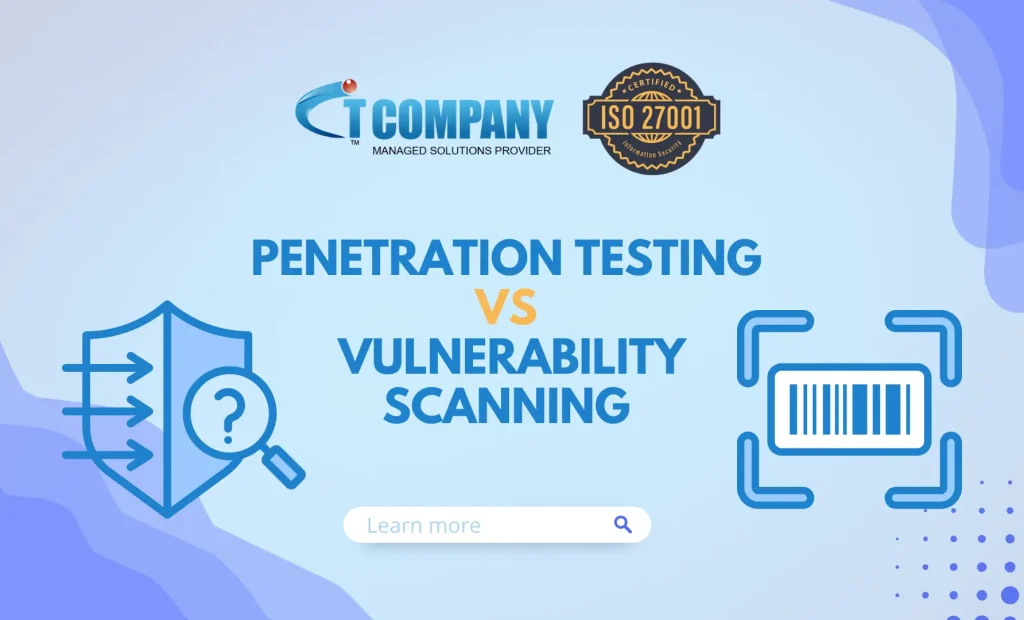
Table of Contents
ToggleWhen considering penetration testing vs vulnerability scanning, it is essential to recognize the distinct roles these two processes play in enhancing an organization’s security posture.
While vulnerability scanning is primarily focused on identifying potential security weaknesses in systems, penetration testing takes it a step further by simulating real-world attacks to determine how effectively those vulnerabilities can be exploited.
For organizations looking to strengthen their security infrastructure, partnering with an IT company that offers ISO 27001 certified services can be highly beneficial. We specialized in delivering both penetration testing and vulnerability scanning, ensuring that comprehensive security measures are in place to protect sensitive data and maintain compliance with international standards.
Understanding Penetration Testing and Vulnerability Scanning
Vulnerability Scanning
Key Features of Vulnerability Scanning
- Automated Process: Quickly scans entire networks with minimal manual intervention.
- Regularly Scheduled: Typically performed on a routine basis, often weekly or monthly.
- Comprehensive Reports: Provides extensive lists of vulnerabilities categorized by severity.
- Cost-Effective: Generally, more affordable than penetration testing, making it accessible for regular use.
Penetration Testing
Penetration testing, or ethical hacking, involves simulating cyberattacks on your systems to identify vulnerabilities that could be exploited by malicious hackers. This method is more targeted and in-depth, providing insights into how a real-world attack could impact your organization.
Key Features of Penetration Testing
- Human Expertise: Performed by skilled security professionals who mimic the tactics of actual attackers.
- Scenario-Based: Focuses on specific systems, applications, or entry points based on risk assessments.
- Detailed Analysis: Offers a deep understanding of potential attack vectors and their possible impacts.
- Validation: Verifies the effectiveness of existing security measures and configurations.
Comparison Chart: Penetration Testing vs Vulnerability Scanning
| Feature | Penetration Testing | Vulnerability Scanning |
| Purpose | Simulates real-world attacks to identify exploitable vulnerabilities | Identifies known vulnerabilities in systems and applications |
| Methodology | Involves manual and automated techniques to assess security | Primarily automated assessments using predefined tools |
| Scope | Focused and targeted on specific systems or applications | Broad scan of entire networks or systems |
| Frequency | Typically conducted on a periodic basis, often annually or semi-annually | Performed more frequently, such as weekly or monthly |
| Human Involvement | Requires skilled security professionals for execution | Can be conducted with minimal human intervention |
| Cost | Generally, more expensive due to the complexity and expertise required | More cost-effective, making it accessible for regular use |
| Outcome | Detailed report that includes exploitation potential and risk assessment | Comprehensive list of vulnerabilities with remediation suggestions |
| Compliance | Often required for compliance with certain regulations | Supports compliance efforts by identifying and mitigating risks |
This chart provides a succinct overview of the key differences and similarities between penetration testing and vulnerability scanning, aiding organizations in determining which approach best suits their security needs.
Which Comes First?
Start with Vulnerability Scanning
To lay the groundwork for a secure environment, begin with vulnerability scanning. Here is why:
- Baseline Security Posture: Vulnerability scanning helps establish a baseline by identifying known vulnerabilities across your network.
- Cost-Effectiveness: Due to its automated nature, vulnerability scanning is more budget-friendly and can be implemented frequently.
- Foundation for Prioritization: By revealing high-priority issues, vulnerability scanning allows you to address glaring vulnerabilities before more extensive testing.
Follow Up with Penetration Testing
Once you have a clear picture of your current security posture and have addressed critical vulnerabilities, move on to penetration testing:
- Simulate Real Attacks: Penetration testing dives deeper, assessing how well your systems stand up to realistic attack scenarios.
- Validate Fixes: Ensure that the vulnerabilities identified during scanning have been effectively mitigated.
- Gain Strategic Insights: Understand the potential impact of advanced threats and strengthen defenses accordingly.
Conclusion
Both vulnerability scanning and penetration testing are vital components of a robust cybersecurity strategy. Begin with regular vulnerability scans to maintain a consistent security baseline and address known weaknesses. Then, apply penetration testing to simulate real-world attacks, validate your defenses, and gain strategic insights into your threat landscape.

For IT Managers, Security Analysts, and CTOs, implementing these processes in tandem ensures a proactive and resilient approach to safeguarding your organization. Prioritize your security initiatives today and fortify your defenses against tomorrow’s threats.




